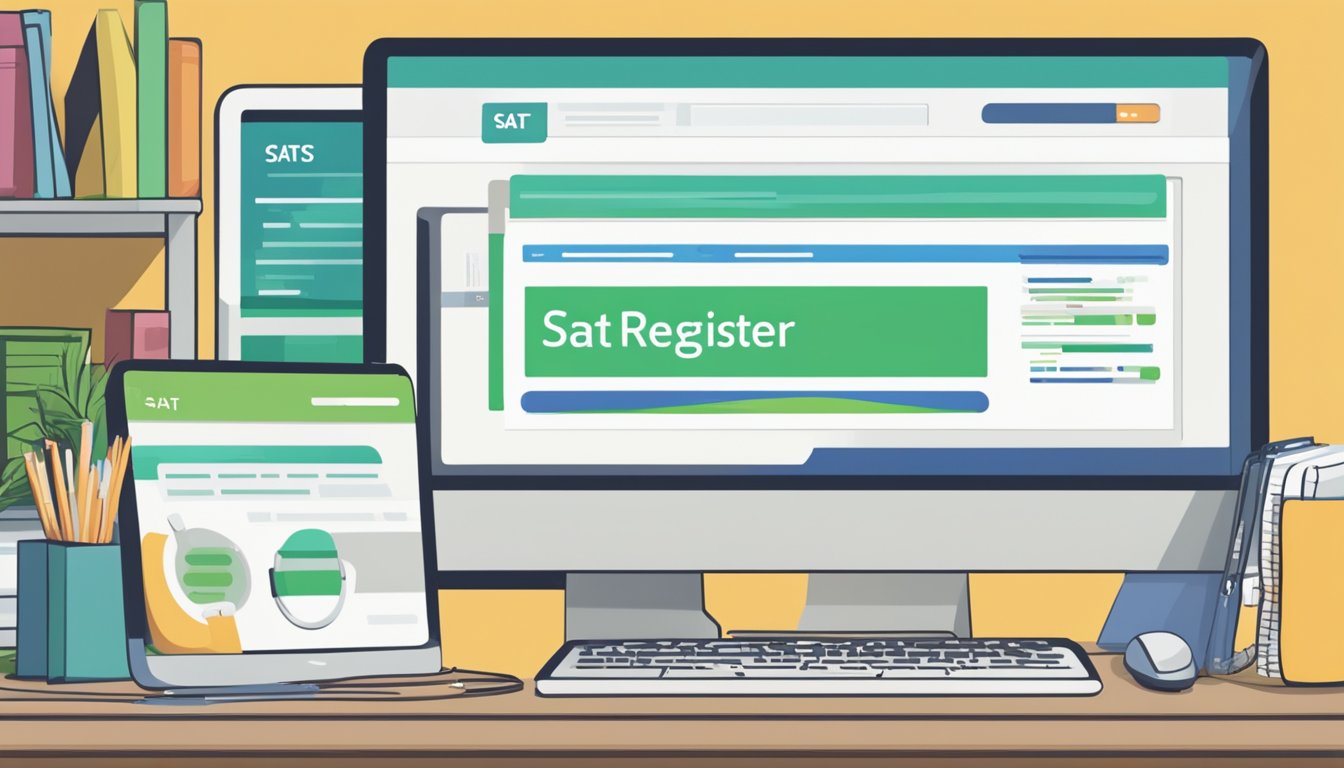How to Register for the SAT: A Step-by-Step Guide
The SAT is a standardized test for college admissions in the United States. It is designed to assess a student’s readiness for college-level work and is accepted by all colleges and universities in the U.S. The test covers reading, writing, and math skills and includes an optional essay section.
Why Register for the SAT
Registering for the SAT is essential for students planning to apply for college. The SAT is a standardized test that measures a student’s readiness for college and is used by many colleges and universities as part of their admission process.
Here are some reasons why registering for the SAT is beneficial:
- Colleges require it: Many colleges and universities require applicants to submit their SAT scores as part of the admission process. By registering for the SAT, students meet this requirement and show they are serious about college applications.
- Admission opportunities: Registering for the SAT can open up more student admission opportunities. Colleges and universities use SAT scores to determine admission decisions, and higher scores can increase a student’s chances of acceptance.
- Scholarship opportunities: Many colleges and universities offer scholarships based on SAT scores. By registering for the SAT and achieving high scores, students can increase their chances of receiving scholarships that can help cover the cost of college.
- College preparation: The SAT measures a student’s readiness for college-level work. By registering for the SAT and preparing for the test, students are also preparing themselves for the academic challenges they will face in college.
How to Register Online
Registering for the SAT online is the easiest and most convenient way to sign up for the exam. To register online, test-takers must have a College Board account, a photo, and a form of payment ready.
To start the registration process, test-takers should visit the College Board website and sign in to their account. They can create one for free if they do not have an account.
Once logged in, they can click the “Register for the SAT” button and follow the prompts to provide their personal information, including their full legal name, date of birth, gender, mailing address, and current grade level.
Test-takers must also upload a photo that meets the College Board’s requirements. The photo should be a recent, recognizable headshot of the test-taker, taken against a plain white or off-white background. The photo should be in JPEG format, with a file size between 10 K.B. and 300KB.
Test-takers must select a test date and location after providing their personal information and uploading their photo. They can choose from available dates and locations near their area. If they are eligible for fee waivers, they can register for free.
Finally, test-takers will need to provide payment for the exam. They can pay online using a credit card or debit card. The cost of the SAT varies depending on the location and whether or not the test-taker chooses to take the optional essay section.
Registration Deadlines
Registering for the SAT requires paying attention to the registration deadlines. All deadlines expire at 11:59 p.m. E.T.; U.S. Students should aim to register as early as possible to secure their preferred test date and test center location.
Late registration is available for an additional fee, but students are not guaranteed to get their preferred test date or test center location.
🌟 Hey Students! 🚀 Ready for the ultimate experience? Join us on Studentsinside.com's Facebook, YouTube, WhatsApp, and LinkedIn. Click now for tips, fun, and success vibes! 🌈✨ #StudentLife #JoinUs
For the 2023-2024 academic year, the registration deadline for the December Digital SAT for international students is November 17, 2023. The late registration deadline for the December SAT for domestic students is November 21, 2023.
Students should note that the late registration deadline is not available for students taking the SAT with accommodations.
Choosing a Test Date
The College Board offers multiple test dates throughout the year, typically Saturdays. However, if you cannot take the test on a Saturday due to religious or other reasons, Sunday alternate dates are usually available.
Most students take the SAT for the first time in the spring of their junior year and then again in the fall of their senior year. However, the specific timing may vary depending on your circumstances. It’s essential to consider your schedule and academic goals when choosing a test date.
To help you plan, the College Board provides official SAT dates and registration deadlines. All deadlines expire at 11:59 p.m. E.T., U.S. You can use the test center search tool the College Board provides to find an SAT center near you.
Once you have chosen a test date, you can sign in to your free College Board account to register for the test. It’s important to note that you must register for yourself, as your parent or counselor cannot do it for you. Make sure to register by the deadline to avoid any late fees.
Understanding SAT Scores
SAT scores are an essential factor in college admissions. Understanding how the scores are calculated and what they mean can help students determine their strengths and weaknesses and make informed decisions about their college applications.
The SAT is scored on a scale of 400 to 1600, with separate scores for the Math and Evidence-Based Reading and Writing sections. The essay section is scored separately on a scale of 2 to 8.
The scores are calculated based on the number of correct answers and the number of incorrect answers. There is no penalty for guessing, so students should answer every question, even if they are unsure of the answer.
In addition to the raw scores, students receive a percentile rank, which compares their scores to those of other students who took the test. For example, a percentile rank of 75 means that the student scored higher than 75% of those who took the test.
Fee Structure and Waivers
To register for the SAT, students need to pay a registration fee. As of 2023, the registration fee is $60 for U.S. test-takers. However, some students may be eligible for a fee waiver.
The College Board offers fee waivers to assist eligible SAT and PSAT/NMSQT students. Low-income students can take the SAT for free and get benefits such as unlimited free scores. If a student qualifies for an SAT fee waiver, they can take the SAT twice for free.
Students must meet specific criteria to be eligible for an SAT fee waiver. The fee waiver is available to low-income students in the United States, U.S. territories, and Puerto Rico. Students enrolled in the National School Lunch Program or other government assistance programs may qualify for a fee waiver.
To access fee waiver benefits, students must have accepted their benefits or used a fee waiver when they registered for a test. They can view fee waiver benefits in their College Board account.
In addition to the registration fee, additional fees may be charged for services such as changing the test center or test date. Students should review the latest SAT registration fees for U.S. test-takers on the College Board website. International students should check the international fees.
Late Registration Process
Late registration for the SAT follows the same process as regular registration but with a few additional steps. Late registration is available for domestic students only and is typically open for two weeks after the regular registration deadline. Late registration costs an additional $30 on top of the standard registration fees.
To register for the SAT during the late registration period, students can either register online or by mail. If registering online, students must create a College Board account and provide their personal information, including their name, date of birth, and contact information. They will also need to select their preferred test date and test center location.
If registering by mail, students must download and print the SAT registration form from the College Board website. They must complete the form, mail it to the address listed, and pay the registration fees.

Information for International Students
International students who wish to take the SAT can register online through the College Board website. The SAT is available to students in over 200 countries and is accepted by universities in the United States and over 80 other countries.
When registering for the SAT, international students should keep in mind the following information:
- The SAT is offered several times yearly outside the United States and U.S. territories. Students should review the international SAT dates and deadlines to determine the best test time.
- The registration fee for international students varies by country. It includes a basic registration fee plus additional fees for optional services such as late registration, test date changes, and score reports.
- Students who require special accommodations, such as extra time or a separate testing room, must submit a request and appropriate documentation to the College Board at least six weeks before their scheduled test date.
- International students who cannot take the SAT in their home country may be able to take the test at a nearby test center in another country. However, availability may be limited, and additional fees may apply.
Test Center Details
Test centers are typically located in high schools or colleges, and the College Board website offers a search tool to help students find a location near them.
It is important to note that test center availability is not guaranteed, and some locations may fill up quickly. It is recommended that students register for the SAT as early as possible to ensure they can take the test at their preferred location.
Students should arrive at the test center at least 30 minutes before the scheduled start time on test day. They must bring their admission ticket, a valid photo I.D., and any other materials required by the test center.
Test center staff will provide instructions for checking in, storing personal belongings, and navigating the testing process. Students should follow all instructions carefully to ensure a smooth and successful testing experience.
Test centers may sometimes close due to unforeseen circumstances such as inclement weather or other emergencies. In these situations, the College Board will attempt to notify affected students as soon as possible and provide options for rescheduling the test.
Required Personal Information
When registering for the SAT, some personal information requirements must be provided. These include the student’s full legal name as it appears on their photo I.D., date of birth, gender, mailing address, and current grade level. Ensuring this information is accurate and up-to-date is essential to avoid any issues during registration.
Additionally, students can provide a preferred first name on their College Board account. This can be useful for students who go by a name different from their legal name, such as a nickname or middle name.
Another essential requirement is a photo of the student. This photo must meet specific requirements, such as being recent, in color, and showing the student’s entire face. The photo will be used for identification purposes on test day, so it is essential to ensure that it clearly and accurately represents the student.
Finally, students must provide information about their high school, including their name and address. This information sends score reports to high school students and helps colleges and universities identify potential applicants.
Special Considerations
There are a few special considerations to remember when registering for the SAT, especially for certain groups of students.
Homeschooled Students
Homeschooled students can take the SAT just like any other student. However, they may need to take some additional steps to register. When registering, they must provide a Homeschool Code, which they can obtain from the College Board website. They will also need proof of their homeschool status, such as a letter from their parent or guardian or a transcript from their homeschool program.
Students with Disabilities
Students with disabilities can request accommodations when registering for the SAT. They must provide documentation of their disability and the accommodations they require. Accommodations include extra time, extended breaks, or the use of a computer or other assistive technology.
International Students
International students can take the SAT at testing centers around the world. However, registration deadlines and test dates may vary depending on the location. International students may also need to provide additional documentation, such as a passport or visa when registering.
Fee Waivers
Fee waivers are available for students who cannot afford the cost of the SAT. Students who are eligible for fee waivers can register for free. To be eligible, students must meet specific income guidelines or be enrolled in a government program, such as the National School Lunch Program.
Digital SAT Registration
Registering for the digital SAT is a straightforward process that can be completed online. Students can register for the digital SAT through the College Board website.
The digital SAT is available in select locations and test centers, so students should check the availability of the digital SAT in their area before registering.
Students must create a College Board account to register for the digital SAT. Once they have created an account, students can register for the digital SAT by selecting their preferred test date and center. The registration process for the digital SAT is similar to that of the paper-and-pencil SAT.
Students who register for the digital SAT will receive an email confirmation once their registration is complete. They will also receive a reminder email a few days before the test date. On test day, students must bring a valid form of identification and their admission ticket.
In addition, students who register for the digital SAT can take advantage of free online practice resources, including full-length practice tests and personalized study plans. These resources can help students prepare for the digital SAT and improve their scores.
Cancellation Policy
Canceling an SAT registration is possible but has some specific rules and fees. You can do so through your My SAT account if you cancel your registration. Here are the details regarding the cancellation policy:
- If you cancel your registration before or on test day, you will receive a refund, but you will be charged a cancellation fee.
- If you cancel your registration by Thursday, 11:59 p.m. E.T., before test day, you will receive a full refund of your registration fee, but you will still be charged a cancellation fee.
- If you cancel your registration after the test day, you will not receive any refund.
The cancellation fee is currently $10.00. Remember that if you registered for the SAT with an Essay, you cannot cancel the Essay portion alone. You must cancel the entire registration.
If you miss the test day without canceling your registration, you will not receive a refund, and your absence will be recorded as a “no-show.” In this case, you will need to register and pay again to take the test on a future date.
Preparation Tips
Preparing for the SAT can be daunting, but anyone can achieve their target score with the right approach. Here are some tips to help you prepare for the SAT:
1. Start Early
Preparing for the SAT three months before the test date is recommended. This will give you enough time to cover all the topics and practice enough to feel confident on test day.
2. Create a Study Plan
Creating a study plan will help you stay on track and cover all the necessary topics. Divide your study time into manageable chunks and assign specific topics to each session. Be sure to include regular practice tests to track your progress.
3. Practice Regularly
Consistent practice is key to performing well on the SAT. Set aside time each week to practice and review material. Use practice tests to identify areas where you need improvement and focus on those topics.
4. Review Homework and Class Notes
Reviewing class notes and homework assignments can help reinforce what you have learned. Take the time to go over your notes and identify areas where you need more practice.
5. Participate in Activities
Participating in extracurricular activities can help you develop skills valuable on the SAT. Join a debate club, volunteer, or participate in a sports team to develop critical thinking, time management, and teamwork skills.
6. Use Review Materials
There are many review materials available to help you prepare for the SAT. Review books, online resources, and practice tests supplement your study plan.








